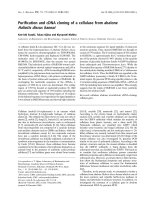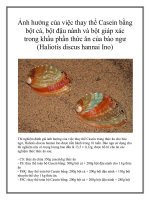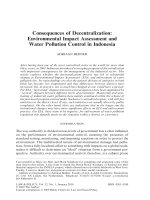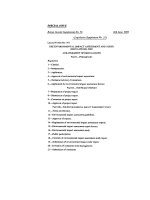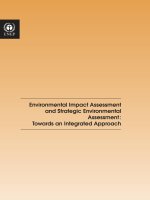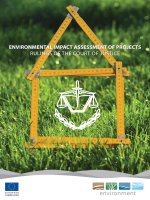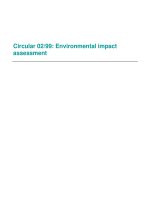Marine Environmental Impact Assessment of Abalone, Haliotis discus hannai, Cage Farm in Wando, Republic of Korea
Bạn đang xem bản rút gọn của tài liệu. Xem và tải ngay bản đầy đủ của tài liệu tại đây (566.14 KB, 11 trang )
Article
Ocean Sci. J. (2015) 50(4):657667
/>
Available online at
Article
pISSN 1738-5261
eISSN 2005-7172
Marine Environmental Impact Assessment of Abalone, Haliotis discus hannai,
Cage Farm in Wan-do, Republic of Korea
Hyun-Taik Oh1*, Rae-Hong Jung2, Yoon-Sik Cho3, Dong-Woon Hwang2, and Yong-Min Yi1
1
Marine and Fisheries Environmental Impact Assessment Center, National Institute of Fisheries Science (NIFS), Busan 46083, Korea
Marine Environment Research Division, National Institute of Fisheries Science (NIFS), Busan 46083, Korea
3
Coastal Wetland Research Institute, National Institute of Fisheries Science (NIFS), Gunsan 54014, Korea
2
Received 22 February 2015; Revised 10 August 2015; Accepted 30 August 2015
KSO, KIOST and Springer 2015
Abstract To assess the marine environmental impacts of abalone,
Haliotis discus hannai, cage farms in Wan-do, we monitored the
benthic environment on top of the sediment underneath cage farm
stations and reference stations. We applied two methods for this
assessment. One was the A- and B-investigation of the MOM system
(Modeling – On fish farm – Monitoring) developed in Norway.
The other was a general environmental monitoring method which
is widely used. In this study, we found benthic animals in all samples
that belonged to condition 1 which were based on group 1(presence
of macrofauna) of the B-investigation method. The values of redox
potential (group 2 – pH, redox potential) in all samples were above
+65 mV belonging to condition 1. Based on sensory results (group
3 – gas, color, odor, thickness of deposits), five out of seven experiment
samples showed condition 1 while stations 2 and 7 showed condition
2, which have been cultured for 10 years in semi-closed waters. As
group 2 takes precedence over group 3, the level of the conditions
for B-investigation results consequently showed condition 1 in all
stations. We found that pollutants and trace metals in the sediment
underneath cage farms were lower than the pollution standard. This
led us to conclude that the environmental impacts of the cage farms
in this study were not significant.
Key words environmental impact assessment, abalone cage
farm, MOM, benthic environment
1. Introduction
Concerns about the marine environmental impact of fish
farms have grown as marine pollution caused by fish farming
has increased. Marine cage farming affects the marine
environment in a variety of ways. In general, the impact of
*Corresponding author. E-mail:
fish cage farms is more serious than that of shellfish cage farms
like abalone cultures and long-line cultures like oysters and
clams. This is due to overfeeding, nutrient loading of individual
organisms, and waste from fish farm facilities (Silvert 1992;
Naylor et al. 2000; Sarà et al. 2004). The enrichment of organic
materials both from fish and abalone cage farms may cause
the reduction of demanded oxygen (DO) in lower levels of
water, not only generating a high concentration of acid-volatile
sulfide (AVS) in sediment, but changing benthic communities
around the farms (Yokoyama 2002, 2003; Kalantzi and
Karakassis 2006). The environmental impact assessment (EIA)
of cage farms has been studied and monitored in Africa,
Asia-Pacific, Europe, and America with different specialized
methods for each case (FAO 2009). The highest application
of EIA to cage farms has been found in the finfish aquaculture
industries of salmon, seabream, sea bass, and tuna around
Europe and also in shellfish and seaweed farming in Europe,
Norway, Australia, and China (Hansen et al. 2001; Crawford et
al. 2003; Borja et al. 2009; Zhang et al. 2009).
A report from the Food and Agriculture Organization
(FAO) of the United Nations documented that the Norwegian
Modeling – On fish farming – Monitoring (MOM) is reliable,
fit for the purpose, and is cost-effective to assess the marine
environmental impact of cage culture (FAO 2009). Even though
the MOM system was developed primarily as an environmental
impact assessment tool for fish cage farming, it is based on
the general parameters for proper marine environmental
management of cage farms, including finfish, shellfish, and
seaweed culture (Zhang et al. 2009). The MOM has A-B-C
investigation methods according to temporal and spatial features.
658
Oh, H.-T. et al.
The A-investigation is a monthly or seasonal measurement
of the sedimentation rate of the organic material underneath
a cage farm. It provides fish-farmers with immediate information
regarding the load as a part of their internal control routines,
which do not have any environmental quality standards
(Hansen et al. 2001). The B-investigation is performed annually
or biannually in the local impact zone, and combines benthic
communities from Group 1, the pH-redox potential from
Group 2, and sensory parameters from Group 3. The Cinvestigation is performed from the intermediate impact zone
to the regional impact zone, and is the study of a benthic
community structure (Ervik et al. 1997; Maroni 2000). The
frequency of monitoring depends on the degree of environmental
impact. For A-investigation and B-investigation, the frequencies
of monitoring are every month, every 2nd month, every 3rd
month and twice a year, every year, every 2nd year, respectively.
Abalone, Haliotis discus hannal, production in South
Korea soared to 1,065 tons in 2003 from 85 tons at the
beginning of 2000 thanks to the development of net cage
technology which is a coastal water-based culture (Park and
Kim 2013). The cost of abalone farming is generally much
cheaper than that of land-based culture. In 2011, Korea
produced 6,800 tons of abalone and it was the second largest
amount in the world. Jeollanam-do is the leading producer
of abalone, accounting for 99% of the total production in S.
Korea. Located within Jeollanam-do, Wan-do produces
about 94% of this total and this is why the island is called the
Mecca of the abalone industry in Korea. The gravest threat
to the abalone industry in Wan-do is the increasing mortality
rate. The reasons for the increasing mortality rate are very
complicated and diverse. Causes include: deteriorated currents
due to the densely distributed farms, depleted-oxygen due to
long-chained farms and seaweed. Vulnerability caused by
storms and typhoons during the summer also contributes to
this problem. Nonetheless, most of the studies that have
been conducted have focused on the environmental impact
of fish farming and research on shell farming has seldom
been carried out.
In this context, this study is aimed at evaluating the impacts
of bio-deposits excreted by abalone and fall-offs of seaweed
in the benthic environment using the Norwegian MOM system
at a variety of licensed abalone farms in Wan-do. Through
this experiment, we aim to determine two things. Firstly, we
will determine the immediate quantification of the benthic
environment on site using the B-investigation methods.
Secondly, we will collect detailed environmental information
including the condition of benthic communities and the
concentration of pollutants and trace metals underneath
abalone farms through laboratory analysis.
2. Data and Methods
Study sites
The study sites are located in Wan-do, Jeollanam-do, in
the southern seas of the Korean peninsula. The sampling stations
for the benthic environmental assessment are underneath
the abalone cage farms near Saengil-do and Geumil-do (Fig.
1). The average depth of the study sites are approximately 18
m, and the depth of each station and license information are
shown in Table 1. The field trip for sediment sampling and
investigation on site took place between November 1 and
November 3, 2013. The tidal range in Wan-do is about 2 m
and the sea water is exchanged by the tide through open
channels. The average velocities of the currents are between
89.2 cm·s-1 and 93.9 cm·s-1 (Yang 2011). Around these islands,
sea-farmers have developed abalone culture facilities next
to seaweed farms since 2003 with the supplementation of
abalone seedling production in the waters (Park and Kim
2013). As the abalone eat the abundant forms of seaweed
such as kelp, Saccharina japonica, and undaria, Undaria
pinnatitida, Wan-do has become an optimal location for
abalone farms since the early 2000s.
Sampling and analysis
For this study, 9 stations for benthic samples and investigation
were selected on the basis of the period of time they had been
involved in abalone aquaculture. Taking vessel tracks into
account, we chose 3 stations in possession of licenses for
abalone aquaculture for almost 9–10 years (1, 2, 7) and 4
stations that were in possession of the same licenses for 4–6
years (3, 4, 5, 6) (Table 1). We chose two reference stations
which were neither utilized for abalone culture nor seaweed
culture in the inner waters (8) and on the way to a channel (9).
Samples for the benthic environmental assessment were
in accordance with MOM B-investigation data and were
collected at abalone farms (1 to 7) and reference stations (8
to 9) by a van Veen grab (0.05 m2). Using the first collection
of the samples, we monitored the pH-redox potential and
sensory parameters on site, and then moved those samples to
a sieve and added two more collections for the macrofauna
abundance experiment (0.15 m2). Finally, benthic samples
were sieved with a 1-mm mesh sieve, checked for remaining
659
Environmental Impact Assessment of Abalone Farms
Fig. 1. (a) The research site in Wan-do and sampling stations for experiment (#1–#7) and reference (#8–#9), (b) The sampling station of
abalone cage farms and the research vessel, (c) abalone net cage culture
Table 1. The information of sampling stations including license number, first date of license, name of species for culture, renew date, area of
farms, and water depth (* indicates 9–10 years old abalone cage farms)
No
#1
#2
#3
#4
#5
#6
#7
#8
#9
License No.
11711
12076
12470
12723
12738
12464
11792
-
License Date
2003-06-24 *
2004-09-23 *
2007-08-21
2009-01-22
2009-04-01
2007-08-21
2004-08-10 *
-
Species
Net cage (Abalone)
Net cage (Abalone)
Net cage (Abalone)
Net cage (Abalone)
Net cage (Abalone)
Net cage (Abalone)
Net cage (Abalone)
-
macrofauna left on the sieve, and then preserved for laboratory
analysis and macrofauna classification. In addition, the
unsieved sediment samples were preserved on site and
transferred to the laboratory to analyze the total organic
carbon (TOC, mg·g-1), total nitrogen (TN, mg·g-1), ignition
loss (IL, %), and trace metals such as Arsenic (As, mg·kg-1),
Cadmium (Cd, mg·kg-1), Chromium (Cr, mg·kg-1), Copper
(Cu, mg·kg-1), Lead (Pb, mg·kg-1), Zink (Zn, mg·kg-1) and
Mercury (Hg, mg·kg-1). We analyzed the content of COD,
IL, and TOC based on the standard experimental method for
the marine environment. For the analysis of trace metals,
dried samples were digested in a mixture of HNO3, HF and
HClO4 and analyzed using an inductively coupled plasma
Renew Date
2013-06-23
2015-09-22
2017-08-20
2019-01-21
2019-03-31
2017-08-20
2014-08-09
-
Area(Ha)
3
5
10
3
4
5
4
-
Depth(m)
20
15
20
25
15
20
20
12
15
mass spectrometer (ICP-MS, Perkin Elmer Elan-6000) at
the National Institute of Fisheries Science (NIFS). The
recovery rates for the target heavy metals in the standard
reference materials were reasonably good (82–100%).
MOM modeling
In each station, we followed the scoring system of the
MOM B-investigation and this generally means that the lower
the score is, the better the benthic environment is, following
the Norwegian Standards Association (Ervik et al. 1997;
Hansen et al. 2001). For macrofauna, we assigned a score of
0 if materials remaining on the mesh screen contained
macrofauna, or 1 otherwise. For the investigation of the benthic
660
Oh, H.-T. et al.
Table 2. Environmental monitoring methodology of both Norwegian MOM investigation A-B and general environmental monitoring in
Korea
Type
Determinant
Unit
Scoring
Condition
A-Investigation Sedimentation rate
mm/year
Value
Presence = 0
mean score 0.5: condition 1, 2 or 3
Group 1
ind./0.15m2
Absence = 1
mean score > 0.5: condition 4
(Presence of macrofauna)
mean score 1: condition 1
0, 1, 2, 3, 5
Group 2
1 < mean score 2: condition 2
mV
(Schaanning and
(pH and redox)
2 < mean score 3: condition 3
Hansen, 2005)
mean score > 3: condition 4
Quantitative
Absence = 0
Outgassing
assessment of
Presence = 4
gas bubbles
Subjective
Pale/Gray = 0
Color
visual
Brown/Black = 2
assessment
B-Investigation
Subjective
None = 0
Smell
olfactory
Medium = 2
mean score < 4: condition 1
Group 3
assessment
Strong = 4
4 mean score < 10: condition 2
(Sensory
10 mean score 14: condition 3
Subjective
Firm
=
0
parameters)
mean score > 14: condition 4
Consistency tactile
Soft = 2
assessment
Loose = 4
Quantitative
< 1/4 = 0
Grab volume assessment of
1/4 ~3/4 = 1
grab volume
> 3/4 = 2
Quantitative
< 2 cm = 0
Thickness of
assessment of
2 ~ 8 cm = 1
deposits
seposits
> 8 cm = 2
Sedimentary parameters
TOC, TN : mg-1
Concentration
General
(TOC, TN, IL)
IL : %
investigation
Trace metals (As, Cd, Cr, Cu, Pb, Zn, Hg)Concentration
mg kg-1
communities underneath the abalone farms, a qualified
taxonomist investigated the macrofauna species. Based on
the observation results of the pH and redox potential at 2 cm
depth in all sites, we assigned the score of 0, 1, 2, 3, and 5 in
accordance with the Norwegian standards(Schaanning and
Hansen 2005). Sensory parameters such as outgassing, color,
smell, consistency, grab volume and the thickness of deposits
were scored 0, 1, 2 or 4 depending on the extent to which a
parameter is affected by organic enrichment. The more the
sediment is affected by organic materials, the higher the
score assigned to the sensory parameters (Table 2). The
analysis of the aforementioned parameters is shown in Table
2 below.
3. Results
Group 1 (benthic community)
The group 1 parameter is a determinant of whether sediment
samples contain macrofauna or not. Macrofauna were found
in all of the samples from all stations after sieving through a
1-mm mesh sieve, so all sites were given the score of 0 which
means that circumstances at all stations were acceptable or
satisfactory. The mean score of all the samples at the study
sites was 0, indicating that the group 1 condition was normal
at the study sites. The most abundant species at each sample
station were polychaetes. A total of 41 polychaetes were identified
with Paralacydonia paradoxa, Sternaspis scutata, Amaeana
occidentalis, Cirrophorus branchiatus and Flabelligeridae
unid making up the majority, and their appearance frequencies
were 67%, 78%, 44%, 44% and 56%, respectively (Table 3).
The number of the species in each station ranged from 4–18
per 0.15 m2. The highest quantities were found at the inner
sites near the islands (#5, #7, #8). The lowest quantity was
found at the reference station #9 in the open channel where
we could take only small sediment samples due to strong
currents and hard consistency with no cage farms around.
Even if a taxonomist could classify the lowest number
polychaete species at sampling station 9, its evaluated
661
Environmental Impact Assessment of Abalone Farms
Table 3. The macrofauna abundance (ind./0.15 m2) at experiment sites (#1#7) and reference sites (#8#9)
Species of macrofauna
#1
#2
#3
#4
#5
#6
#7
Existence
Yes
Yes
Yes
Yes
Yes
Yes
Yes
Score
0
0
0
0
0
0
0
Level of condition
(1~3)
(1~3)
(1~3)
(1~3)
(1~3)
(1~3)
(1~3)
Amaeana occidentalis
10
5
10
20
Ammotrypane aulogaster
Ampharete arcrica
10
Amphisamytha japonica
10
Aphelochaeta monilaris
5
5
5
5
Archianellida unid.
10
Capitella capitata
5
Cirrophorus branchiatus
15
20
15
Dorvillea rudolphi
5
Euchone alicaudata
5
Flabelligeridae unid.
5
10
10
Glycera chirori
5
10
Harmothoe imbricata
5
Harmothoninae unid.
5
Heteromastus filiformis
15
5
5
5
Lagis bocki
Lepidonotinae unid.
5
10
Lumbrineris cruzensis
5
Magelona japonica
5
Mediomastus californiensis
40
20
15
Minuspio multibranchiata
5
Nectoneanthes multignatha
5
Nephtys polybranchia
5
10
5
Paralacydonia paradoxa
40
10
5
5
35
Paraonis glacilis japonica
15
Paraprionospio cordifolia
5
Poecilochaetidae unid.
5
5
Praxillella affinis
10
Prionospio saccifera
10
Scolelepis sp.
10
Scoloplos armeger
Sigambra tentaculata
10
5
10
Spiochaetopterus koreana
5
Sternaspis scutata
5
25
20
30
10
Sthenolepis japonica
5
5
Syllidae unid.1
5
10
Terebellides japonica
5
10
5
Tharyx sp.
5
Thelepus sp.
10
Species number
8
8
8
9
13
6
18
Diversity index
2.61
2.91
2.65
2.93
3.53
2.04
3.92
sediment condition was still based on group 2 and 3,
showing that nutrient concentration and trace metals were
#8
Yes
0
(1~3)
10
5
#9
Yes
0
(1~3)
10
10
10
30
5
5
25
35
5
5
5
5
5
10
5
10
14
3.38
4
1.91
still good (Table 4, Table 5).
The Shannon-Wiener index ranged between 1.91–3.92
662
Oh, H.-T. et al.
Table 4. The pH and redox potential values, concentration of nutrients, and trace metals in the sediment
Content
Parameter
Unit
#1
#2
#3
#4
#5
#6
pH
7.95
7.81
7.81
7.95
7.75
7.85
B-Investigation
redox potential
mV
99.5
79.9
85.2 115.5 65.5
110.5
(Group 2)
Level of condition
1
1
1
1
1
1
IL
%
5.47
5.58
4.46
5.78
3.58
5.16
Sedimentary
TN
mg·g-1
1.45
1.41
0.71
1.35
0.45
1.15
parameters
TOC
mg·g-1
10.31
9.95
5.51
9.85
3.35
8.31
Sand
%
1.1
0.8
5.2
1.5
27.3
3.1
Silt
%
50.1
48.2
36.6
33.2
43.6
53.6
Clay
%
48.8
51.0
58.2
65.3
29.1
43.3
Sediment grain
Mean
Φ
7.9
8.1
8.5
9.2
6.2
7.2
Sort
3.3
3.3
3.4
3.0
3.4
3.3
Skewness
0.2
0.1
-0.1
-0.3
0.9
0.4
Kurtosis
1.7
1.6
1.7
2.0
2.4
1.7
As
mg·kg-1
6.78
6.66
6.01
6.93
5.34
5.99
Cd
mg·kg-1
0.03
0.05
0.04
0.03
0.03
0.05
50.19
52.39 49.81 53.38 40.13 48.14
Cr
mg·kg-1
Harmful
Cu
mg·kg-1
16.95
18.14 14.72 18.39 11.81 16.31
substances
Pb
mg·kg-1
25.73
26.72 22.37 27.41 19.78 22.45
86.17
90.42
80
92.41 64.19
96.6
Zn
mg·kg-1
Hg
mg·kg-1
0.02
0.015 0.008 0.014 0.008 0.013
Table 5. Sensory results both for abalone cage farm stations (#1–#7) and reference stations (#8–#9)
Content
Parameter
#1
#2
#3
#4
#5
B-Investigation (Group 3)
Outgassing
0
0
0
0
0
Color
0
0
0
0
0
Smell
0
0
0
0
0
Consistency
2
2
2
0
2
Grab volume
1
2
1
1
1
Thickness of deposits
0
0
0
0
0
Sum(scores)
3
4
3
1
3
Level of condition
1
2
1
1
1
which indicated that the conditions of all stations in our study
were better than those of shellfish and seaweed farming areas in a
similar study (1.8–2.3) carried out in China (Zhang et al.
2009). Group 1 and polychaete community results revealed
that there were not any significant differences between sampling
stations in terms of the number of species, as the results of
ANOVA showed that the significance probability was above
0.05. Overall, the sediments underneath abalone cage farms
in the study sites were still in an acceptable or satisfactory
condition.
Group 2 (chemical values)
Group 2 parameters for the Norwegian B-investigation
are based on the measurement of pH and redox potential
#6
0
0
0
2
1
0
3
1
#7
7.71
105.5
1
5.21
0.95
6.95
2.7
56.1
41.2
7.8
3.3
0.5
1.7
6.14
0.03
57.95
17.72
26.96
89.86
0.013
#8
7.8
135.5
1
5.61
1.25
9.35
5.5
40.7
53.8
8.9
3.4
0.0
1.8
5.29
0.05
51.37
17.13
23.43
85.13
0.014
#9
7.8
130.5
1
5.45
1.15
7.85
1.9
53.1
45.0
7.5
3.3
0.3
1.6
6.12
0.03
54.02
17.41
24.07
85.3
0.014
#7
0
2
2
2
1
0
7
2
#8
0
0
0
2
1
0
3
1
#9
0
0
0
0
1
0
1
1
ascertained by inserting electrodes into the sediment (Hansen et
al. 1997). The pH and redox potential in the sediment was
measured immediately after the samples were collected from a
depth of 20 mm at all stations. The pH and redox potential
(Eh) values ranged between 7.71–8.09 and 65.0–135.1 mV,
respectively. The assigned scores based on the pH and redox
potential values are 0 (#4, #6, #7, #8, #9) and 1 (#1, #2, #3, #5), so
the level of the conditions at all sites is 1 (Table 4). Scores for
the pH and redox potential were analyzed 0 or 1 according to
a previous study by Schannig and Hansen (2005), and the
scores were applicable to all sampling stations for condition
1. This was based on group 2 of the B-investigation method.
Even though the values of reference stations (#8, #9) were
higher than those of the experimental stations (#1–#7), the
Environmental Impact Assessment of Abalone Farms
differences were trivial and all values were mostly
concentrated in the border of 0 and 1. According to the group
2 result, the environmental conditions in all stations meet the
standards for a well-oxygenated marine environment with
low organic input and favorable conditions for the presence
of benthic communities. Our measurements were not made
at different levels of depth but only at a depth of 20 mm to
examine the systematic pH and redox potential differences
between farming grounds and reference stations.
The sand, silt, and clay amounts or ratios were collected
underneath the cage farms using a ternary figure based on
the Shepard classification scheme (Shepard 1954). The average
composition of gravel, sand, silt and clay were recorded as
0%, 5.5%, 46.1% and 48.4% respectively (Table 4). The
sediments mostly consisted of silty clay and clayish silt
except at station 5 which was primarily made up of sand at
27.3%. The grain size ranged between 6.2–9.2 Ф which
means that it consisted of very fine silt which was mostly
clay. The sorting values and skewness values ranged between
3.0–3.4 Ф and -0.3–0.9, which means very poorly sorted and
very coarse skewed, respectively. The sorting kurtosis showed
very leptokurtic curves with the value of 1.6–2.4. Our study
sites have cultured abalone since 2004, but the sedimentary
composition has not yet been affected by abalone cage
farms.
The concentration of sedimentary parameters such as IL
(%), TN (mg·g-1), and TOC (mg·g-1) ranged between 3.58–
5.78%, 0.45–1.45 mg·g-1, 3.35–10.30 mg·g-1 respectively.
The values of IL were mostly within the range of 5.1–5.8%,
but station 5 had the lowest value of 3.58% due to its higher
composition of sand at 27.3%. At station 9, both the TN and
TOC concentrations were lower than those at other stations,
too.
Results indicated that the finer the sediment, the higher the
concentration of pollutants. This is similar to the results of
other related studies conducted at the surface sediment of
cage farms (Matthaei et al. 2006). In Japan, if the concentration
of TOC is above 10.3 mg·g-1 in a fish farm, the responsible
local authority would issue a warning to farmers to take action
to preserve the marine environment according to environmental
quality status (EQS) (Yokoyama 2003). In Europe, if the
concentration of TOC is lower than 11.9 mg·g-1, farmers get
a “Good” or “High” rating based on the European EQS (Bakke
et al. 2010). If the TOC standard of Europe was applied to
abalone cage farms in this study, the values of TOC in all
stations would have been lower than the standard, which indicates
663
that sediment conditions are quite good. The concentrations
of TOC in most of stations were lower than the standards
applied in Japan except for station 1 (10.31 mg·g-1) where the
cage culture has been established since 2003. These parameters
at the cage farms did not reveal any significantly lower values
than those at the reference stations (Table 4). We found that
sedimentary environmental conditions in 8 out of 9 stations
were still good based on the standards of Japan, and all stations
were still environmentally healthy according to European
standards.
The trace metals in the sediment are measured to check the
safety of the abalone cage farming grounds. In this study, the
content of trace metals such as As, Cd, Cr, Cu, Pb, Zn and Hg
were measured underneath cage grounds and reference
stations. According to the United States National Ocean and
Atmosphere Administration (NOAA)’s reference tables for
trace metals in sediment, the critical values of effect range
low (ERL) for As, Cd, Cr, Cu, Pb, Zn and Hg are 8.2 mg·kg-1,
1.2 mg·kg-1, 81.0 mg·kg-1, 34.0 mg·kg-1, 46.7 mg·kg-1, 150.0
mg·kg-1 and 0.15 mg·kg-1 respectively (Buchman 2008).
The values for harmful substances at all stations were lower
than those of the sediment quality guidelines (SQGs). This
suggests that the impacts of trace metals on benthic communities
were negligible. The study sites in Wan-do were also found
not to be significantly polluted by harmful substances, and
healthy sediment conditions had been maintained. The As
value of station 4 was below the standard but close to the
threshold (85%), so more studies are required to identify the
potential causes of metal pollution in abalone cage farms
(Table 4).
Group 3 (sensory values)
Group 3 parameters of the B-investigation show many
sensory variables representing organic enrichment such as
gas ebullition, color, odor, consistency and thickness of sludge.
The results of sensory parameters are shown in Table 5.
Outgassing was not found in any of the sample stations, so
we assigned an on- site score of 0 to them. The colors of
sample sites were gray (score = 0) except at station 7 which
was brown-black (score 2). There was no smell from the
sediment samples, but there was a slight sulfide smell from
station 7. The consistency of the sediment was soft and gentle
(score = 2), but station 9 was hard (score = 0). Mostly, the grab
volume was not greater than 3/4 except at station 2 which
got a full volume grab. The thickness of sludge accumulated
on top of the original sediment ranged between 0.6–1.5 cm,
664
Oh, H.-T. et al.
Fig. 2. The results of pH and redox potential based on previous
measurements from various cage farms in Europe (Schanning
and Hansen 2005)
so we a score of 0 was assigned for all stations. The total
scores of group 3 in the B-investigation ranged from 1–7,
with station 7 with the highest score and station 9 with the
lowest score. A sum less than 4 falls into condition 1 while
the sum equal to or greater than 4 and less than 9 falls into
condition 2. Therefore, the level of condition based on the
sum of scores was condition 1 for (#1, #3, #4, #5, #6, #7, #8)
and condition 2 for (#2, #7) (Table 5).
As a whole, general conditions were given by the results
of the group 1, 2, 3 of the B-investigation. Most sample
stations (#1, #3, #4, #5, #6, #8, #9) showed the same level of
conditions with both group 2 and 3 containing macrofauna.
Therefore, we determined that the general condition of
stations 1, 3, 4, 5, 6, 8 and 9 were 1. However, samples from
station 2 and 7 were different from group 2 and 3. If they are
different, group 2 takes precedence over group 3 (Ervik et al.
1997; Hanse et al. 2001). Therefore we determined that the
general conditions of station 2 and 7 were 1 because the
condition of the station is determined by group 2 (Table 6).
We found that sedimentary environmental conditions in all
Table 6. General level of condition of the sediment in Wan-do
Content
#1
#2
#3
Group 1 condition
Yes
Yes
Yes
Group 2 condition
1
1
1
Group 3 condition
1
2
1
General condition
1
1
1
Sedimentary condition Normal
Good
Good
Trace metals (ERL)
None
None
None
Fig. 3. Ternary diagram for sedimentary composition around cage
farm in Wan-do
sites were still good judging by the concentration of IL, TN
and TOC, even though the value of TOC in station 1 was similar
to the value of standard applied in Japan for marine environmental
fish farm preservation. In Wan-do, the concentrations of
trace metals were below the limit of ERL, which indicates
that the environment is still clean (Table 4).
4. Discussion
The increasing age of a farm is likely related to worsening
conditions
Abalone cage farms in Wan-do, Jeollanam-do have been
intensely developed since the early 2000s with the development
of net cage technology in coastal waters. With the increasing
abalone mortality rate, farmers have become seriously concerns
about the environmental impacts of the abalone cage farms
and the densely distributed facilities in a limited site area.
#4
Yes
1
1
1
Good
None
#5
Yes
1
1
1
Good
None
#6
Yes
1
1
1
Good
None
#7
Yes
1
2
1
Good
None
#8
Yes
1
1
1
Good
None
#9
Yes
1
1
1
Good
None
Environmental Impact Assessment of Abalone Farms
Meanwhile, a marine environmental monitoring program
by the NIFS has been undertaken in the coastal waters of S.
Korea. Even though there are a number of observation
stations, they are not close to the abalone farms in Wan-do.
The nearest station of the NIFS is located 3.2 km to the north
and 4.7 km to the west of the abalone cage farms in this
study. To assess the marine environmental impacts of cage
farms, regular monitoring is needed directly underneath
cage farms because the impacts of sedimentary parameters
should be measured within 30 to 50 m of cage centered
grounds. In this study, we concluded that the general conditions
underneath abalone cage farms were pretty good, though the
values of some stations were a little higher than those of the
reference stations. In particular, the 10 year-old licensed
cage farms (stations 2 and 7) showed the level of condition
2 according to the sensory parameters of the B-investigation
method. Also, the value of TOC at station 1, a 10 year-old
licensed cage farm, was higher than the standard applied at
fish farms in Japan (Yokoyama 2003). More extensive and
regular interdisciplinary studies in close proximity to abalone
cage farms are required to investigate the potential pollution
of bio-deposits excreted by abalone, fall-off from seaweed,
and harmful substances in the sediment. Without the environmental
impact assessment of abalone cage farms, a local authority
cannot take prompt action to determine the causes of unexpected
deaths among abalone cultures which may be related to
oxygen-depletion and environmental changes.
K-MOM necessity
The MOM system was developed for the assessment of
the marine environmental impacts of intensive marine fish
farming in Norwegian waters (Ervik et al. 1997). It covers the
environmental impacts not only in local and intermediate
zones through the A and B investigation methods but also in
intermediate and regional zones by C-investigation methods.
And it allows for an immediate assessment to be carried out
on site and can be conducted easily and the results sent to the
laboratory for analysis by professionally skilled technicians
and taxonomists. This convenient method allows local
fishermen to receive the training to carry out the measurements.
The general concept of the MOM system is based on a general
assessment of the marine environment regardless of the
species being reared or cultivated. Both fish cage farming
and abalone cage farming have similar impacts on the benthic
environment, even though fish cage farming affects the
marine environment in a slightly more detrimental manner
665
than abalone cage farming. To date, most of the researches
conducted have been focusing on fish farming. However,
environmental problems have started to occur in the abalone
cage farming industry and this has led to a decrease in
productivity. We have ascertained that the environmental
impact around abalone cage farms in Wan-do can also be
assessed using this system. We assigned a score range to a
schematic assessment map based on our observation results.
To use this pH-redox potential method frequently, we need
to collect more measurements from several more culture
grounds. Measurements need to be made at different levels
of depth in core samples, and then the lowest pH and the
corresponding redox potential should be used to assign
scores. The group 3 parameters provide reliable information
on sediment conditions. Visual observation is also a good
way to obtain valuable information on the marine environment,
but it has been underestimated as an adequate tool to obtain
measurement results with respect to sedimentary parameters
and trace metals. More extensive studies on sensory parameters
are required to improve them as a reliable method. This can
be accomplished through a questionnaire survey by experts
based on a dataset. Eventually, we need to put in place Korea
– MOM (K-MOM) to properly evaluate the licensed culture
farms.
Better understanding of hydrodynamics
The marine environmental impacts of cage farms are
closely related to farming locations (Karakassis et al. 2000).
The stronger the current is, the less polluted the environment
is with fewer deposits of pollutants and pseudofaeces by
abalone and the absence of excessive input of seaweed
deposits underneath farms. Densely distributed facilities of
abalone cage farms and long-chained farms cause the slowing
of water flow and water exchange, especially in semi-closed
waters. Although we have data on average current speeds
and tidal range from Wan-do, these are not reliable as they
were not measured close to the cage farms. In the study sites,
the speed and patterns of currents as well as the amount of
sea water exchanges could be one of the main reasons for
variations in biological and chemical parameters, but those
physical characteristics were beyond the scope of this study.
On a national and regional level, the concerned authorities
should consider those physical characteristics when they
prepare the relocation of and new licenses for abalone cage
farms in the near future. Our knowledge of hydrodynamic
conditions can help us better understand the parameters that
666
Oh, H.-T. et al.
are represented and where alternative farming sites should
be located.
5. Conclusion
In this study, we evaluated the marine environmental impacts
of abalone cage farms using the MOM system and compared
sedimentary parameters and trace metals in Wan-do, S.
Korea. We found the general level of the condition which
was given by the results of group 1, 2, 3 of B-investigation
methods was 1 in all abalone cage and references stations.
We found macrofauna in all stations. The most abundant
species was polychaete with Sternaspis scutata, Paralacydonia
paradoxa, Cirrophorus branchiatus, Flabelligeridae unid
and Amaeana occidentalis as the major variety. The pH and
redox potential (Eh) values ranged between 7.71–8.09,
65.0–135.1 mV, respectively. The assigned scores based on
the pH and redox potential are 0 (#4, #6, #7, #8, #9) and 1
(#1, #2, #3, #5), so the level of conditions in all sites is 1. The
total scores of group 3 in the B-investigation ranged between
1–7, and the level of the conditions based on the sum of the
scores was condition 1 (#1, #3, #4, #5, #6, #7, #8) and
condition 2 (#2, #7). If group 2 and group 3 bring a different
result, group 2 takes precedence over group 3. Therefore, we
determined the level of the general condition as condition 1.
We found that sedimentary environmental conditions are
still good in all sites judging by the concentration of IL, TN,
and TOC. The concentration of the trace metals was below
the limit of ERL which indicates that the areas are in a good
environmental condition.
Acknowledgements
This work is funded by a grant from the National Institute
of Fisheries Science (RP-2015-ME-036).
References
Bakke T, Källqvist T, Ruus A, Breedveld GD, Hylland K (2010).
Development of sediment quality criteria in Norway. J Soils
Sediments 10(2):172–178
Borja Á, Rodríguez JG, Black K, Bodoy A, Emblow C, Fernandes
TF, Forte J, Karakassis I, Muxika I, Nickell TD, Papageorgiou
N, Pranovi F, Sevastou K, Tomassetti P, Angel D (2009). Assessing
the suitability of a range of benthic indices in the evaluation of
environmental impact of fin and shellfish aquaculture located
in sites across Europe. Aquaculture 293(3–4):231–240
Buchman MF (2008) NOAA screening quick reference tables.
National Oceanic and Atmospheric Administration, Seattle,
NOAA OR&R Report 08-1, 34 p
Crawford CM., Macleod CKA, Mitchell IM (2003) Effects of
shellfish farming on the benthic environment. Aquaculture
224(1):117–140
Ervik A, Hansen PK, Aure J, Stigebrandt A, Johannessen P, Jahnsen T
(1997) Regulating the local environmental impact of intensive
marine fish farming I. The concept of the MOM system
(Modelling-Ongrowing fish farms-Monitoring). Aquaculture
158(1):85–94
FAO (2009) Environmental impact assessment and monitoring in
aquaculture. FAO, Rome, FAO fisheries and aquaculture technical
paper 527, 57 p
Hansen PK, Ervik A, Aure K, Johannessen J, Jahnsen P, Stigebrandt T,
Schaanning A (1997) MOM. Concept and revised edition of
monitoring program 1997. Institute of Marine Research, Bergen,
51 p
Hansen PK, Ervik A, Schaanning M, Johannessen P, Aure J, Jahnsen T,
Stigebrandt A (2001) Regulating the local environmental impact
of intensive, marine fish farming: II. The monitoring programme
of the MOM system (Modelling–Ongrowing Fish farms–
Monitoring). Aquaculture 194(1):75–92
Kalantzi I, Karakassis I (2006) Benthic impacts of fish farming:
meta-analysis of community and geochemical data. Mar Pollut
Bull 52(5):484–493
Karakassis I, Tsapakis M, Hatziyanni E, Papadopoulou KN, Plaiti
W (2000) Impact of cage farming of fish on the seabed in three
mediterranean coastal areas. ICES J Mar Sci 57(5):1462–1471
Maroni K (2000) Monitoring and regulation of marine aquaculture in
Norway. J Appl Ichthyol 16(4–5):192–195
Matthaei CD, Weller F, Kelly DW, Townsend CR (2006) Impacts
of fine sediment addition to tussock, pasture, dairy and deer
farming streams in New Zealand. Freshwater Biol 51(11):2154–
2172
Naylor RL, Goldburg RJ, Primavera JH, Kautsky N, Beveridge
MCM, Clay J, Folke C, Lubchenco J, Mooney H, Troell M (2000)
Effect of aquaculture on world fish supplies. Nature 405:1017–
1024
Park CJ, Kim SY (2013) Abalone aquaculture in Korea. J Shellfish
Res 32(1):17–19
Sarà G, Scilipoti D, Mazzola, Modica A (2004) Effects of fish
farming waste to sedimentary and particulate organic matter
in a southern Mediterranean area (Gulf of Castellammare, Sicily):
a multiple stable isotope study. Aquaculture 234(1):199–213
Schaanning MT, Hansen PK (2005) The suitability of electrode
measurements for assessment of benthic organic impact and
their use in a management system for marine fish farms. In:
Hargrave B (ed) Environmental effects of marine finfish
aquaculture. Springer, Berlin, pp 381–408
Shepard FP (1954) Nomenclature based on sand-silt-clay ratios. J
Sediment Res 24(3):151–158
Environmental Impact Assessment of Abalone Farms
Silvert W (1992) Assessing environmental impacts of finfish
aquaculture in marine waters. Aquaculture 107(1):67–79
Yang CJ (2011) A Study on tidal current energy in the sea near Wando.
J Korean Soc Mar Eng 35(1):126–132
Yokoyama H (2002) Impact of fish and pearl farming on the benthic
environments in Gokasho Bay: evaluation from seasonal fluctuations
of the macrobenthos. Fisheries Sci 68(2):258–268
667
Yokoyama H (2003) Environmental quality criteria for fish farms
in Japan. Aquaculture 226(1):45–56
Zhang J, Hansen PK, Fang J, Wang W, Jiang Z (2009) Assessment
of the local environmental impact of intensive marine shellfish
and seaweed farming—application of the MOM system in the
Sungo Bay, China. Aquaculture 287(3):304–310
